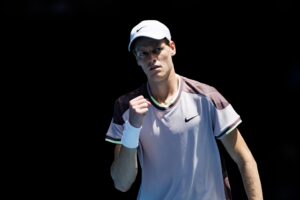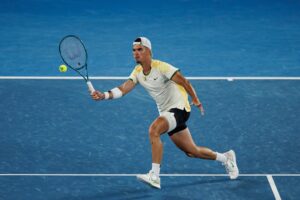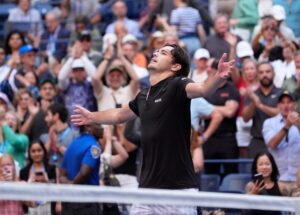Queen’s Club has the second largest trophy in tennis, with only the Davis Cup dwarfing the enormous piece of silverware that the traditional men’s warm-up tournament for Wimbledon awards. However, even more impressive than that trophy itself is the fact that winning Queen’s has so often proved to be the last staging post for male tennis players on the way to triumphing at Wimbledon. That has been true of many of the sport’s greatest ever champions, from Rod Laver to John McEnroe, and from Boris Becker to Andy Murray. Will winning Queen’s prove similarly transformational for the newest great male tennis player, Carlos Alcaraz?
A Great Week At Queen’s For The Young King of Tennis
The young Spaniard’s straight-sets triumph (6-4 6-4) in the Queen’s final over Australia’s Alex de Minaur was the culmination of a magnificent week on one of the most beautiful tennis courts in the world – indeed, one whose beauty arguably exceeds even that of Wimbledon’s far larger Centre Court. De Minaur had been in outstanding form going into the final, having beaten, among others, Murray en route. Ultimately, however, like so many other fine tennis players before him (and surely after him, too), de Minaur was swept aside by Alcaraz.
It had been the same in Alcaraz’s semifinal against Sebastian Korda. The young American had beaten Alcaraz before, at Monte Carlo last year, and broke him in the very first game of the Queen’s semifinal, which, given Korda’s own powerful serve, hardly augured well for Alcaraz. But the young Spaniard simply achieved the “boomerang break” of breaking back immediately, and never looked back after that to win in straight sets (6-3 6-4).
Furthermore, in Alcaraz’s quarterfinal against Jiri Lehecka of the Czech Republic, yet another of the fine young players who should be his direct contemporaries and peers, he had also relatively easily dismissed a player who, before the match, had generally been thought capable of extending him. Instead, Alcaraz won 6-2 6-3.
To have won in succession against three such good players with such apparently consummate ease is yet another reminder of why Alcaraz is rated so highly and already thought to be potentially the most complete player that tennis has ever seen. As I have written before, he is the ultimate post-Big Three player in that he seems to combine the best elements of each of those three great players, being as comfortable at the net as Federer, baselining like Nadal and defending like Djokovic. (For good measure, he even has the strangulated grunt of Murray, the fourth best male player of the last 20 years.)
It is that completeness of game that not only makes Alcaraz an all-court player but, crucially, an all-surface player. And having already excelled on hardcourt (winning the US Open last September) and clay (winning several clay-court titles and reaching the semifinals at Roland Garros this year, where only extreme cramping prevented him from giving Djokovic, the eventual champion, a real run for his money), Alcaraz might just be ready to conquer grass, too.
Fast Learner Alcaraz Is Learning Fast on Grass
Queen’s is Alcaraz’s first title on grass and in winning it he completed one of the most incredible improvements on the surface seen in recent years. In his very first match, he had played France’s Arthur Rinderknech (another French Arthur after Arthur Fils had pulled out) and very nearly lost. He only won through in a third-set tie-break and in that first match of the tournament he displayed that he is still a newcomer to grass, for example approaching the net behind insufficiently deep shots, such that Rinderknech could pass him with relative ease.
By the end of the week, however, and the final against de Minaur, it was as if Alcaraz had completed several years of grass-court preparation in just a single week. He was moving much more easily and confidently, approaching the net only behind the deepest and most-difficult-to-return shots and generally looking as completely at ease on a bright green tennis court as he has on red clay courts and dark blue hardcourts.
As John Lloyd, the BBC commentator and former Grand Slam singles finalist, said after Alcaraz’s victory, it is only the greatest tennis players who can adapt to a relatively alien surface so quickly and so comprehensively. As a result, Lloyd suggested (like so many) that Alcaraz is already second favourite to win Wimbledon this year behind Novak Djokovic.
Of course, in one respect it makes complete sense that Alcaraz should adapt to grass so quickly. Precisely because it is the fastest and most unpredictable surface in tennis, and because it is played on so rarely (only for the one-month window before and including Wimbledon), it is the hardest surface to play on and the most difficult to adjust to, especially after the long clay-court season that precedes it. However, Alcaraz has already shown that he is an incredibly fast learner, so it is appropriate that he should adapt so quickly to the fastest surface of all.
Alcaraz is already a Grand Slam Champion and the youngest ever world #1 (at just 19) since the world rankings were first introduced almost exactly fifty years ago. So, it would be entirely consistent with his most rapid of career ascents if he were to seriously challenge at Wimbledon this year, or even win.
Alcaraz Has A Penchant For The Impossible – And Will Need It
Perhaps the other defining quality of Alcaraz (in addition to all his extraordinary physical attributes) is what might be called a penchant for the impossible – put simply, he routinely does what had often been thought undoable before him. In his breakthrough win in Rio last year, he virtually played a tournament in a single day, after heavy rain necessitated the playing of the quarterfinal, semi`final and final all within 24 hours, but he still won through against a host of top 10 players. Then, barely a month later, he became the first man to beat both Rafael Nadal and Djokovic at the same clay court event (the Madrid Masters). Indeed, not only did he beat both of these true greats but he did so back to back and after suffering a seemingly serious ankle injury in the first match.
It is feats such as those, as well as his amazing triumph at the US Open (which included coming back from match-points down against Jannik Sinner in the quarterfinal to win in five sets), that have made tennis fans believe Alcaraz is capable of almost anything. Well, if that is true, then he is about to face the biggest test of his superhuman powers at Wimbledon 2023.
Can He Possibly Beat Djokovic On Grass?
The test that awaits Alcaraz at Wimbledon is arguably the toughest test in tennis right now and probably one of the toughest tests in the entirety of tennis history, namely beating defending champion and seven-time Wimbledon winner Djokovic on grass. Prior to Queen’s, that had been thought incredibly unlikely to say the least, but after Alcaraz’s hypersonic progress on grass over the last week it no longer seems so far-fetched.
Of course Djokovic will be the favourite for Wimbledon, where, if he wins, he will match Roger Federer’s men’s singles record of eight victories. And of course it is only just a few weeks since Djokovic reminded everyone of his own superhuman physical prowess by effectively grinding Alcaraz into the red dirt of Roland Garros. Yes, Alcaraz suffered terrible cramps that effectively ended the match as a contest, but it is extremely unlikely that he would have suffered such debilitating spasms against any other player except “The Serbinator” (the man who, like Schwarzenegger’s The Terminator, just will not stop).
Nevertheless, that match might yet prove a blessing in disguise (heavy disguise, admittedly) for Alcaraz. He admitted immediately afterwards that a large part of the reason he had cramped so badly was simply that he had been so nervous and even hyped-up to play Djokovic at a Major. Being such a fast and comprehensive learner, it is extraordinarily unlikely that he will make the same mistake again and will prepare for any future encounter with Djokovic in a much quieter, calmer state of mind.
There is no doubting the enormity of the challenge that awaits Alcaraz at Wimbledon if he is to overcome Djokovic and thereby preserve Federer’s last remaining GOAT-like record, namely being GOATOG (Greatest of All Time On Grass). But if anyone can, Alcaraz can. And if he does, he will join the list of truly great tennis players who have achieved the ultimate grass-court double of winning Queen’s and Wimbledon in the same year.
The Five Greatest Queen’s-Wimbledon Doubles (in chronological order)
- Rod Laver (1962)
Rocket Rod had already won Wimbledon (in 1961) before he triumphed at Queen’s, but in 1962 he won Queen’s en route to defending his Wimbledon title, defeating compatriot Roy Emerson in the final 6–4 7–5.
However, after winning Wimbledon again in 1962, to complete his domination of grass (at a time when all of the Majors except for Roland Garros were played on the surface), it would be another six years before Laver could compete at Wimbledon again, having been banned from playing at the Majors because he had turned professional. It was only at the end of the decade, from 1968 onwards, that Laver could return to the Majors and in his long absence it was Emerson who won many of the Grand Slam singles titles that he would surely have won if he had not been banned.
- John McEnroe (1981)
McEnroe’s 1981 triumph at Queen’s completed a hat-trick of triumphs for the brash and brilliant young American, but it was arguably the most important of those victories because it ultimately propelled him to victory at Wimble]don. McEnroe always excelled on grass because he was a natural serve-volleyer, but in 1980 he was unable to translate Queen’s success into Wimbledon triumph, losing the epic Wimbledon final in five sets to Bjorn Borg, who duly completed his own run of five titles in SW19 in a row.
A year later, however, McEnroe could not be stopped and he went straight from a straight-sets victory in the Queen’s Final over compatriot Brian Gottfried to a four-set Wimbledon final victory over Borg, which ended the Swede’s stranglehold on Wimbledon and eventually propelled him into early retirement.
- Boris Becker (1985)
Boris Becker’s Queen’s and Wimbledon double of 1985 is probably the greatest of them all, precisely because it was so surprising. In 1985, of course, Becker was still only 17 and even after he had won Queen’s, beating America’s Johan Kriek in straight sets in the final, he was still not considered a serious contender for the Wimbledon title.
Nevertheless, the German teenager proved once and forever the sheer power of unstoppable momentum as he went seamlessly from winning Queen’s to winning Wimbledon, with his trademark “boom-boom” style of power-play marking the end of the McEnroe-Borg-Connors era at Wimbledon and the start of his own short period of domination in SW19.
- Rafael Nadal (2008)
Federer has never played at Queen’s, having early on his career signed a lifelong contract to appear (either as a player or an ambassador) at one of the few other significant grass-court tournaments before Wimbledon, Halle in Germany. Consequently, the most stylish tennis player ever, especially on grass, never once played competitively on probably the most beautiful grass court in the world.
Arguably, he should have, because it was the fact that Rafael Nadal won at Queen’s in 2008, defeating Djokovic in straight sets in the final, that at last gave the Spaniard the confidence to take on and beat the great Swiss at Wimbledon. Just a few weeks after winning at Queen’s, Nadal finally overcame Federer in the Wimbledon final, winning 9-7 in the fifth set (and the dark) in what promptly overtook Borg-McEnroe 1980 as the greatest grass-court match, and arguably the greatest match on any surface, in tennis history.
1.Andy Murray (2013)
Like McEnroe, Murray had already won Queen’s (in 2009) before he achieved a Queen’s and Wimbledon double in 2013. However, his 2013 triumph, culminating in a three-set win in the final against Marin Čilić, was the final step on the great Scot’s lifelong journey to becoming Britain’s first male Wimbledon champion since Fred Perry in 1936.
Having lost the Wimbledon final a year earlier against Federer, Murray achieved a swift revenge of sorts by winning the Olympic Singles title, on Wimbledon’s Centre Court, against the Swiss. Propelled by the momentum of winning Olympic Gold, Murray duly won his very next Major, the 2012 US Open, and so arrived in London in the summer of 2013 ready for the final onslaught on Wimbledon. And buoyed by that victory against Čilić at Queen’s, he not only reached the final at Wimbledon again but finally won it, defeating Djokovic in straight sets for one of the greatest achievements ever in any sport and not just tennis.
Main photo credit: Susan Mullane-USA TODAY Sports






